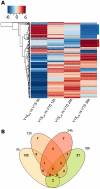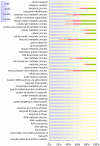Genome wide adaptations of Plasmodium falciparum in response to lumefantrine selective drug pressure
- PMID: 22384044
- PMCID: PMC3288012
- DOI: 10.1371/journal.pone.0031623
Genome wide adaptations of Plasmodium falciparum in response to lumefantrine selective drug pressure
Abstract
The combination therapy of the Artemisinin-derivative Artemether (ART) with Lumefantrine (LM) (Coartem®) is an important malaria treatment regimen in many endemic countries. Resistance to Artemisinin has already been reported, and it is feared that LM resistance (LMR) could also evolve quickly. Therefore molecular markers which can be used to track Coartem® efficacy are urgently needed. Often, stable resistance arises from initial, unstable phenotypes that can be identified in vitro. Here we have used the Plasmodium falciparum multidrug resistant reference strain V1S to induce LMR in vitro by culturing the parasite under continuous drug pressure for 16 months. The initial IC(50) (inhibitory concentration that kills 50% of the parasite population) was 24 nM. The resulting resistant strain V1S(LM), obtained after culture for an estimated 166 cycles under LM pressure, grew steadily in 378 nM of LM, corresponding to 15 times the IC(50) of the parental strain. However, after two weeks of culturing V1S(LM) in drug-free medium, the IC(50) returned to that of the initial, parental strain V1S. This transient drug tolerance was associated with major changes in gene expression profiles: using the PFSANGER Affymetrix custom array, we identified 184 differentially expressed genes in V1S(LM). Among those are 18 known and putative transporters including the multidrug resistance gene 1 (pfmdr1), the multidrug resistance associated protein and the V-type H+ pumping pyrophosphatase 2 (pfvp2) as well as genes associated with fatty acid metabolism. In addition we detected a clear selective advantage provided by two genomic loci in parasites grown under LM drug pressure, suggesting that all, or some of those genes contribute to development of LM tolerance--they may prove useful as molecular markers to monitor P. falciparum LM susceptibility.
Conflict of interest statement
Figures





Similar articles
-
Decreasing pfmdr1 copy number in plasmodium falciparum malaria heightens susceptibility to mefloquine, lumefantrine, halofantrine, quinine, and artemisinin.J Infect Dis. 2006 Aug 15;194(4):528-35. doi: 10.1086/507115. Epub 2006 Jul 11. J Infect Dis. 2006. PMID: 16845638 Free PMC article.
-
In vitro activities of piperaquine, lumefantrine, and dihydroartemisinin in Kenyan Plasmodium falciparum isolates and polymorphisms in pfcrt and pfmdr1.Antimicrob Agents Chemother. 2009 Dec;53(12):5069-73. doi: 10.1128/AAC.00638-09. Epub 2009 Sep 21. Antimicrob Agents Chemother. 2009. PMID: 19770282 Free PMC article.
-
Surveillance of artemether-lumefantrine associated Plasmodium falciparum multidrug resistance protein-1 gene polymorphisms in Tanzania.Malar J. 2014 Jul 9;13:264. doi: 10.1186/1475-2875-13-264. Malar J. 2014. PMID: 25007802 Free PMC article.
-
Update on the in vivo tolerance and in vitro reduced susceptibility to the antimalarial lumefantrine.J Antimicrob Chemother. 2012 Oct;67(10):2309-15. doi: 10.1093/jac/dks252. Epub 2012 Jul 2. J Antimicrob Chemother. 2012. PMID: 22761327 Review.
-
Artemether-lumefantrine: an option for malaria.Ann Pharmacother. 2012 Apr;46(4):567-77. doi: 10.1345/aph.1Q539. Epub 2012 Apr 10. Ann Pharmacother. 2012. PMID: 22496476 Review.
Cited by
-
Plasmodium Helical Interspersed Subtelomeric (PHIST) Proteins, at the Center of Host Cell Remodeling.Microbiol Mol Biol Rev. 2016 Aug 31;80(4):905-27. doi: 10.1128/MMBR.00014-16. Print 2016 Dec. Microbiol Mol Biol Rev. 2016. PMID: 27582258 Free PMC article. Review.
-
Plasmodium falciparum GPCR-like receptor SR25 mediates extracellular K+ sensing coupled to Ca2+ signaling and stress survival.Sci Rep. 2017 Aug 25;7(1):9545. doi: 10.1038/s41598-017-09959-8. Sci Rep. 2017. PMID: 28842684 Free PMC article.
-
The Knockout for G Protein-Coupled Receptor-Like PfSR25 Increases the Susceptibility of Malaria Parasites to the Antimalarials Lumefantrine and Piperaquine but Not to Medicine for Malaria Venture Compounds.Front Microbiol. 2021 Mar 15;12:638869. doi: 10.3389/fmicb.2021.638869. eCollection 2021. Front Microbiol. 2021. PMID: 33790879 Free PMC article.
-
Chemogenomic profiling of Plasmodium falciparum as a tool to aid antimalarial drug discovery.Sci Rep. 2015 Nov 6;5:15930. doi: 10.1038/srep15930. Sci Rep. 2015. PMID: 26541648 Free PMC article.
-
Unravelling the mode of action of the Tres Cantos Antimalarial Set (TCAMS): investigating the mechanism of potent antimalarial compounds potentially targeting the human serotonin receptor.Malar J. 2025 Feb 14;24(1):45. doi: 10.1186/s12936-025-05271-3. Malar J. 2025. PMID: 39953553 Free PMC article.
References
-
- Kokwaro G, Mwai L, Nzila A. Artemether/lumefantrine in the treatment of uncomplicated falciparum malaria. Expert Opin Pharmacother. 2007;8:75–94. - PubMed
-
- Schlitzer M. Malaria Chemotherapeutics Part I: History of Antimalarial Drug Development, Currently Used Therapeutics, and Drugs in Clinical Development. ChemMedChem. 2007;2:944–986. - PubMed
-
- Hastings IM, Ward SA. Coartem (artemether-lumefantrine) in Africa: the beginning of the end? J Infect Dis. 2005;192:1303–1304; author reply 1304–1305. - PubMed
-
- Dean M, Rzhetsky A, Allikmets R. The human ATP-binding cassette (ABC) transporter superfamily. Genome Res. 2001;11:1156–1166. - PubMed
Publication types
MeSH terms
Substances
Grants and funding
LinkOut - more resources
Full Text Sources
Medical

